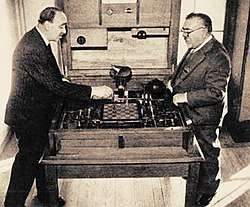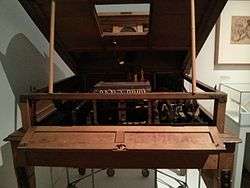El Ajedrecista
El Ajedrecista (English: The Chess Player) is an automaton built in 1912 by Leonardo Torres y Quevedo, one of the first autonomous machines capable of playing chess.[2] As opposed to the human-operated The Turk and Ajeeb, El Ajedrecista was a true automaton built to play chess without human guidance. It played an endgame with three chess pieces, automatically moving a white king and a rook to checkmate the black king moved by a human opponent.

The device could be considered the first computer game in history.[3] It created great excitement when it made its debut, at the University of Paris in 1914. It was first widely mentioned in Scientific American as "Torres and His Remarkable Automatic Devices" on November 6, 1915.[4]
The automaton does not deliver checkmate in the minimum number of moves, nor always within the 50 moves allotted by the fifty-move rule, because of the simple algorithm that calculates the moves. It did, however, checkmate the opponent every time. If an illegal move was made by the opposite player, the automaton would signal it.[5]
Technical description
Its internal construction was published by H. Vigneron.[6] The pieces had a metallic mesh at their base, which closed an electric circuit that encoded their position in the board. When the black king was moved by hand, an algorithm calculated and performed the next best move for the white player.[7]
In the first version, the pieces were plugged into the board, and the game states of check and checkmate were signaled with light bulbs.[2] Leonardo's son Gonzalo made an improved chess automaton based on El Ajedrecista in 1920, which made its moves via electromagnets located under the board.[8] It also included a sound effect, with a voice recording announcing checkmate when the computer won the game.[9]

Both are still working and are on display at the Colegio de Ingenieros de Caminos, Canales y Puertos in Madrid.[10][11]
Notes
- "Chess Programming Wiki- Leonardo Torres y Quevedo". Retrieved 2010-06-12.
- Williams, Andrew (2017-03-16). History of Digital Games: Developments in Art, Design and Interaction. CRC Press. ISBN 9781317503811.
- Montfort, Nick (2003). Twisty Little Passages: An Approach to Interactive Fiction. MIT Press. p. 76. ISBN 0-262-63318-3.
In 1912 Leonardo Torres Quevedo ... devised the first computer game ... The machine played a KRK chess endgame, playing rook and king against a person playing a lone king.
- Torres and his remarkable automatic devices. Issue 2079 of Scientific American, 1915
- Atkinson, George W. (1998). Chess and machine intuition. Intellect Books, pp. 21-22. ISBN 1-871516-44-7
- H. Vigneron: Robots. English Translation in: David Levy, Monty Newborn: Chess and Computers, pp. 13-23. Computer Science Press, 1982.
- Velasco, JJ (2011-07-22). "Historia de la tecnología: El ajedrecista, el abuelo de Deep Blue". Hipertextual (in Spanish). Retrieved 2017-08-14.
- Brian Randell, From Analytical Engine to Electronic Digital Computer: The Contributions of Ludgate, Torres and Bush. Annals of the History of Computing, Vol. 4, No. 4, Oct. 1982
- "Leonardo Torres Quevedo, referente para la ingeniería y desconocido para el gran público". eldiario.es (in Spanish). Retrieved 2017-08-14.
- "Universidad Politécnica de Madrid". www.upm.es (in Spanish). Retrieved 2017-08-16.
- "Torres y Quevedo's rook endgame automaton". Chess News. 2004-07-20. Retrieved 2017-08-16.